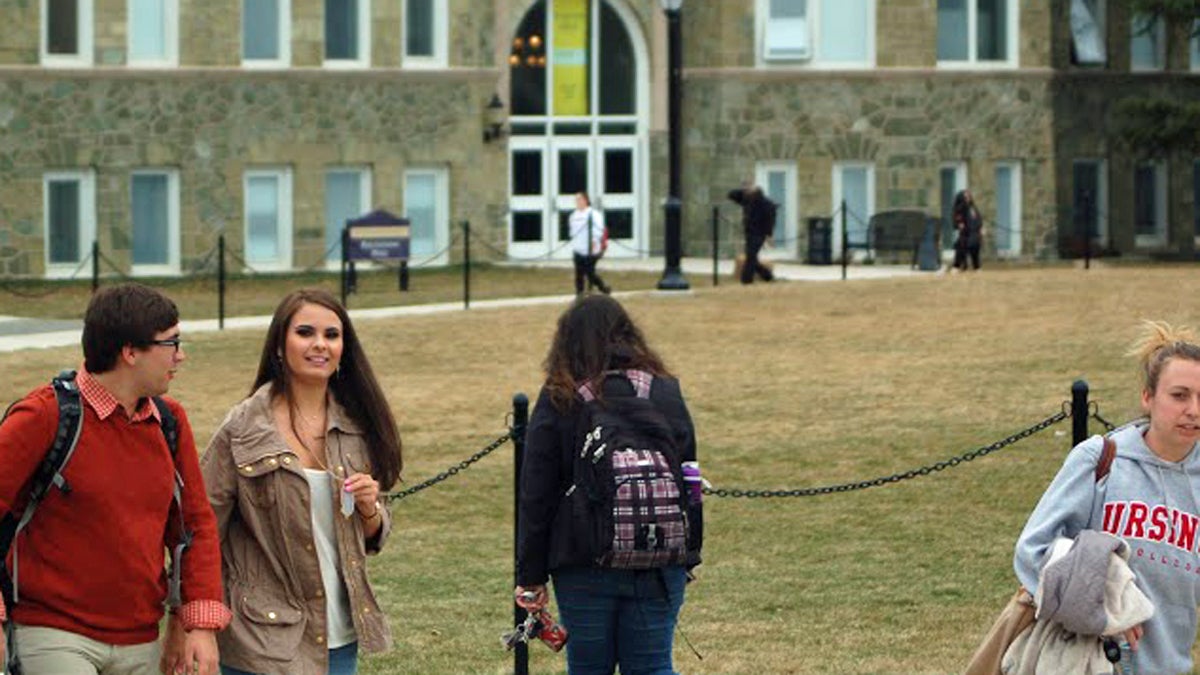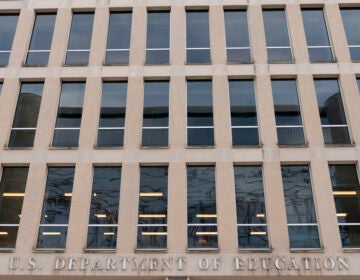Pa. universities looking at rare tuition freeze if Wolf delivers funding boost
Listen
Students walk through campus at West Chester University in Pennsylvania (Sara Hoover/WHYY)
The universities that make up Pennsylvania’s State System of Higher Education serve 15,000 more students than they did 17 years ago. But the state aid is identical, leading the 14 colleges to make significant budget cuts and operate with 800 fewer employees.
Kenn Marshall, spokesperson for the state system, says altogether they’ve cut $270 million.
“I think we’re a very lean organization,” he says. “We’ve reached the point where any further cuts are going to be very, very, very, very difficult without impacting the student services.”
Some of the existing effects include: minimal class size increases, cutting low-enrollment programs and a $1.5 billion backlog in deferred maintenance and building renovations.
Kutztown University’s vice president of administration and finance, Jerry Silberman, says they’ve eliminated more than 130 positions in the past several years.
“We had positions eliminated that had employees filling them at the time, so they were actually real layoffs,” he said. “We had vacant positions that we eliminated. Although those kind of cuts were still painful, it wasn’t as bad as having to say goodbye to an employee.”
He says they’ve seen a 14 percent drop in student enrollment in the past five years.
East Stroudsburg University has seen a similar plunge.
“Based primarily on declining high school graduation numbers and so a smaller number of students to recruit,” said East Stroudsburg President Marcia G. Welsh. “And we are in such a competitive market, we having to do a lot more branding and marketing of ourselves.”
Rising TuitionWhile student enrollment has declined the past few years, the system serves 16 percent more students than it did in the 1990s.
As state funding was cut or held flat, tuition hikes have made up the difference.
Marshall, the system’s spokesperson, says the increases are even with the rate of inflation.
“We’ve had to make some very difficult and very significant choices in cutting costs in order to be able to still balance our budgets with minimal tuition increases,” he said.
The overall cost of attendance still remains below the national and Mid-Atlantic regional averages for public colleges, according to the annual College Board survey. And the state-owned universities remain Pennsylvanians most affordable four-year option.
But even minimal increases are potentially pricing some students and families out.
“There’s no doubt that there are students and families who find it increasingly difficult to afford or attend even our universities,” Marshall said.
Kenneth Long, East Stroudsburg’s vice president of administration and finance, agrees.
“Given the financial constraints of not only the university, but society, any tuition increase does put additional pressures on families, particularly lower income families,” he said.
That’s partly because of a dramatic shift in funding. When Pennsylvania organized these schools into one system in the 1980s, state money accounted for 65 percent of the cost of attendance, and now it only covers 25 percent. Students cover the remaining 75 percent.
The FutureThat’s something Gov. Tom Wolf wants to change with his $45 million proposed increase in state aid.
He asked for a one-year tuition freeze, and the system’s board voted by a narrow margin to freeze tuition if Wolf comes through with the money.
A freeze would be a big deal because only once in the system’s 32-year history has it not raised tuition.
East Stroudsburg’s Kenneth Long says the school welcomes additional dollars, but it’s the same as what they’d get from a tuition increase.
“Where it helps is the families because it actually is a swap for the tuition increase,” he said. “The benefit is actually our students save in their amount in tuition, but for the universities it really is a wash.”
He says university costs are going to continue to increase, and they’ll still be cautious with their budget planning. They expect to break even if there are no salary bumps.
Sister school Kutztown has invested in energy savings that have saved them $750,000 annually, but still faces a deficit, even with the additional dollars.
“In addition to the cuts that we’ve been experiencing, our students and families have had to pay more through tuition increase,” said Kutztown’s Silberman. “These additional funds are very much needed and very much welcome.”
He says Kutztown is focusing on recovering their lost enrollment as a way to solve their fiscal issues.
West Chester University, on the other hand, has seen their student enrollment go up 30 percent and hired more faculty to keep up with the growth.
Vice president of advancement and sponsored research Mark Pavlovich says their additional revenue goes to subsidize sister schools that are struggling.
“As a system, we are supportive of each other and our goal is to make sure all of us can be successful,” he said. “The challenge will come, though, if that becomes the normal practice, and we don’t find ways to strengthen the other institutions, the same problems will be faced by West Chester.”
He says their significant enrollment growth has masked state budget cuts, but they need additional space for their growing population.
“The long-term problem really is state funding and the expectation that we do two things: that state funding remain low and that tuition remain low as fixed costs grow,” Pavlovich said. “For anybody who has a checkbook you know that doesn’t work very long.”
If the funding increase is approved, it would be the largest in the state system’s history.
But so far, Gov. Wolf and the Republicans who control the legislature are not agreeing on much when it comes to the budget.
Editor’s note: Mark Pavlovich, West Chester University’s vice president of advancement and sponsored research, is an emeritus on WHYY’s Community Advisory Board.
WHYY is your source for fact-based, in-depth journalism and information. As a nonprofit organization, we rely on financial support from readers like you. Please give today.




